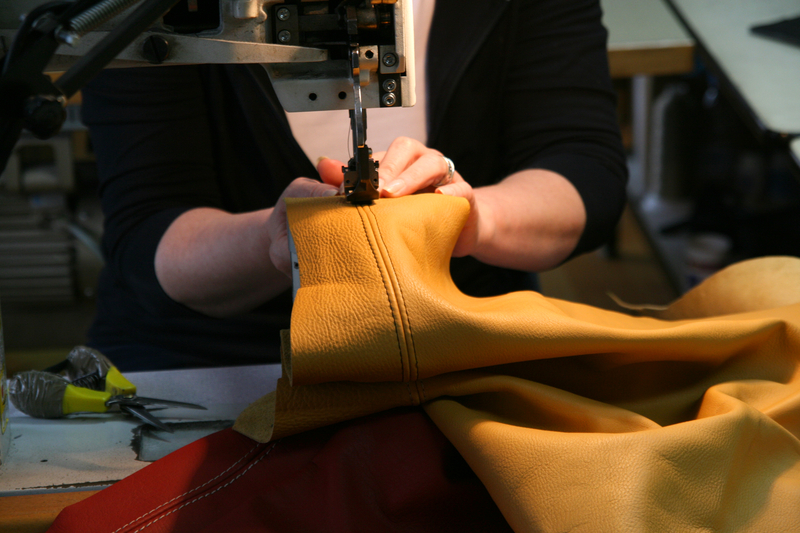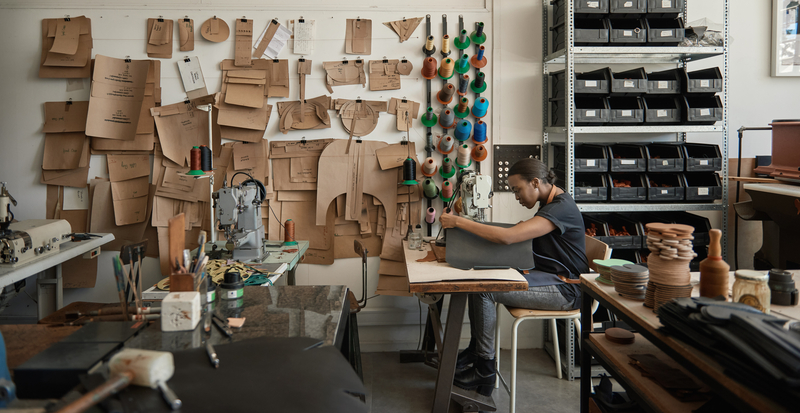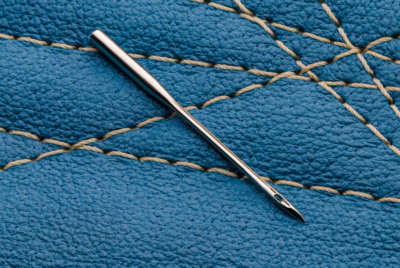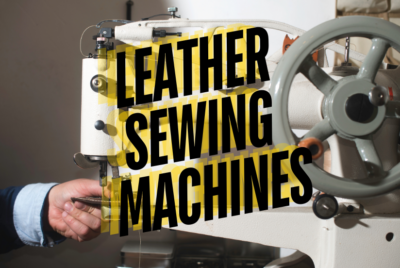Leather Sewing Machine Guide
Whether you’re just beginning your leather sewing machine journey or seeking to expand your advanced skills, welcome to this guide.
This leather sewing machine guide aims to cover the basics.It will assist you in selecting the best leather sewing machine if you are a beginner or expand your sewing knowledge if you are an experienced sewist.
Use the information in this guide to ensure you make an informed decision when selecting a leather sewing machine.
Introduction to Leather Sewing Machines
Leatherworking is an art as ancient as humanity itself. This craft that has evolved from necessity to a form of expression and luxury.
The development of leather sewing machines has revolutionized this craft, making it more accessible and varied in its possibilities. Initially, leather goods were stitched by hand, a labor-intensive process requiring significant skill and patience.

The invention of the leather sewing machine opened new avenues for artisans and hobbyists. It allowed for the creation of a wider range of products with intricate designs and increased durability.
Leather sewing machines are specially designed to handle the unique challenges posed by leather which is a material much tougher than fabric.
These machines come equipped with features that enable them to pierce through thick hides, creating strong, consistent stitches without damaging the material.
From crafting simple leather goods like wallets and belts to more complex items such as jackets, bags, and upholstery, these machines have become indispensable tools in the leatherworking world.
Types of Leather Sewing Machines
You can categorize leather sewing machines for domestic or industrial use.
Domestic Leather Sewing Machines
Domestic leather sewing machines are tailored for personal or small-scale use, perfect for hobbyists or small businesses.
They generally have a more compact design, making them suitable for home studios or spaces with limited storage.
These machines can handle light to medium thickness leather, ideal for projects like handbags, accessories, and garments.
Brands like Singer, Brother, and Juki offer machines that, while less powerful than industrial counterparts, provide versatility and ease of use for everyday projects.
Industrial Leather Sewing Machines
Industrial leather sewing machines are designed for durability and continuous use. They can manage a wide range of leather thicknesses and are essential for producing high volumes of work such as belts, saddles, and heavy-duty bags.
These leather sewing machines come in several types, each suited to specific tasks.
Flatbed Machines
Flatbed machines are the most used type of sewing machine. They are used both in domestic settings and in the industrial leather crafting world. Their design is particularly well-suited for sewing flat pieces of material.
The flatbed provides a stable and extensive workspace. The area allows for precise control and ease of movement of the leather piece under the needle. This makes them ideal for creating wallets, belts, and other similar flat leather goods.
Engineers design industrial flatbed machines to be more robust than their domestic counterparts. These machines feature stronger motors and mechanisms capable of piercing through thicker leathers without compromising stitch quality.
They often have advanced features for leather sewing. These are some of the same ones to consider when choosing your leather sewing machine. Adjustable stitch lengths, higher presser foot lift, and enhanced feeding mechanisms are important features. They are designed to handle the unique properties of leather. Combined these ensure that the material moves smoothly through the machine without sticking or dragging.
Cylinder Arm Machines
Cylinder arm machines are distinguished by their cylindrical arm. It extends from the machine’s base and allows the material to wrap around it during sewing. This design is used for sewing cylindrical or rounded items. Bags, shoes, and even certain types of sporting equipment require this type of machine.
The cylinder arm provides unparalleled access to areas that would be difficult or impossible to reach with a flatbed machine. The sewist can maneuver the leather around the arm for even stitching on every part of the item.
These machines are indispensable in industries requiring flexibility and precision in sewing rounded and three-dimensional items.
The arm’s diameter can vary, with smaller diameters allowing for tighter curves and more intricate work.
Cylinder arm machines may also come with various attachments and feet. These enabe tasks like edge stitching and joining to be executed with precision.
Post Bed Machines
Post bed machines feature a vertical column, or post, rising above the machine’s base, with the needle and feed mechanism mounted at the top of the post.
This configuration allows for greater access to tight areas. It is perfect for detailed work on footwear, upholstered furniture, and other leather goods.
The elevated position of the needle and the smaller base of the post bed machine enable the leather to be freely moved and rotated. This makes it easier to sew complex shapes and patterns.
Post bed machines are particularly favored in the shoe manufacturing industry, where precision around curves and in tight spaces is essential. Like cylinder arm machines, post bed models are equipped with special features and attachments to the specific needs.
Leather Sewing Machine Types Summary
Each type of industrial leather sewing machine offers unique advantages. That makes them suited to specific tasks within leather crafting and manufacturing. The nature of the project will determine the choice among a flatbed, cylinder arm, or post bed machine.
Understanding the capabilities and applications of these machines is crucial for selecting the right equipment. The right equipment leads to high-quality leather goods produced efficiently and effectively.
Brands like Tippmann, Landis, and Weaver are known for their industrial models, offering reliability and precision for professional leatherworkers.
Choosing the Right Leather Sewing Machine
Selecting the ideal leather sewing machine involves reviewing our “Sewing Machine Selection Guide” and then consider factors that are specific to leather projects.
- Material Thickness: The thickness of leather you intend to sew is a primary consideration. Thicker, tougher leathers will require an industrial machine with a stronger motor and specialized needles.
- Project Size: The scale of your projects also dictates the type of machine you need. For large or complex projects, an industrial machine might be necessary for efficiency and quality.
- Budget: Your budget will significantly influence your choice. Domestic machines are more affordable. Investing in an industrial machine might be worthwhile for serious enthusiasts or professionals due to their durability and capability.
Understanding your needs in these areas will help you determine and focus your search for a leather sewing machine.
Popular Leather Sewing Machine Brands
In the world of leather sewing machines, several brands have distinguished themselves through excellence, reliability, performance, and user satisfaction.
Each brand brings its own strengths to the table, catering to various aspects of leatherworking. Here is a look into each of these noteworthy brands and what they offer.
Singer
Singer has been synonymous with sewing machine innovation and quality for over a century. They offer a range of machines that cater to both domestic and industrial needs.
Their domestic machines are praised for being user-friendly and versatile, making them a great choice for beginners and hobbyists.
On the industrial front, Singer machines are known for their robustness and ability to handle a variety of leather thicknesses.
Brother
Brother is recognized for its comprehensive range of sewing machines that have user-friendly features and are versatile. They are designed to meet the needs of both novice and experienced sewists.
Beginner sewists can find models that are simple and straightforward to use. More advanced models featuring a wide range of stitching options and accessories are available for experienced sewists.
Brother’s commitment to innovation and quality ensures that their machines are reliable.
Juki
Renowned for its industrial sewing machines, Juki offers precision and durability that professional leatherworkers swear by.
Juki’s machines are engineered to perform flawlessly on a wide range of materials, including various types of leather, providing clean, consistent stitches every time.
With models designed for heavy-duty work, Juki machines are a go-to for those involved in commercial leather goods production, where reliability and efficiency are critical.
Dürkopp Adler
Dürkopp Adler is known for its high-quality industrial sewing machines that specialize in handling heavy materials, including leather.
With a history of innovation and excellence, Dürkopp Adler machines are engineered for durability and precision. They are particularly noted for their walking foot machines, which are essential for sewing thicker leather evenly and without slippage.
Dürkopp Adler’s robust machines are ideal for those requiring reliability in high-volume or specialized leather manufacturing environments.
Tippmann
Tippmann industrial sewing machines carve a niche for themselves by offering models that are incredibly robust and capable of sewing some of the thickest leathers with ease.
Their manual and pneumatic machines are especially favored for custom leatherwork, including saddlery, harnesses, and other heavy-duty applications.
Tippmann’s machines stand out for their unique blend of simplicity and sheer power, making them a favorite among artisans who work with very thick leather.
Landis
Landis specializes in machines that are tailored for shoe and boot making, along with other leather goods.
Known for their rugged durability and exceptional performance, Landis machines have been a staple in the footwear industry for decades.
They offer a range of machines suitable for different stages of shoe and boot manufacturing, from initial assembly to finishing touches, ensuring precision and quality in every stitch.
Weaver
Weaver Leather Supply caters to the needs of leathercrafters by offering a selection of heavy-duty sewing machines.
Their machines are designed to handle a wide range of leatherworking projects, from belts and bags to more complex saddlery and tack.
These machines combine ease of use with exceptional power and durability, making them a popular choice among both professional leatherworkers and hobbyists.
TechSew
TechSew has become a brand synonymous with high-quality leather sewing machines, designed for both small businesses and hobbyists.
Often, their machines come equipped with specialized features such as servo motors, speed reducers, and walking feet. These facilitate precise control and ease of use on heavy and complex leather projects.
TechSew’s dedication to customer service and providing value-added features makes their machines a worthwhile investment for serious leather crafters.
Cobra
Cobra sewing machines are highly regarded in the leatherworking community for their exceptional quality and capability to handle a vast range of leather thicknesses and types.
There are a variety of models, including flatbeds, cylinder arms, and post beds, designed to meet the specific needs of leather crafters.
Known for their durability and reliability, Cobra machines are equipped to tackle everything from light leather garments to heavy-duty tack and saddlery.
Pfaff
Pfaff stands as a hallmark of German engineering and precision in the sewing machine industry. They are renowned for high-quality domestic and industrial sewing machines that cater to a wide array of sewing needs, including expert leatherworking.
Pfaff’s machines are celebrated for their innovation, such as the Integrated Dual Feed Technology (IDT™), which ensures even fabric feeding from both the top and bottom. This technology is particularly beneficial when working with leather. It helps prevent the material from shifting and ensures uniform stitching.
Leather Sewing Machine Brands Summary
Each of these brands has established a solid reputation within the leatherworking community for their quality, reliability, and specific strengths.
When choosing a leather sewing machine, consider the specific features and capabilities of each brand and model, and how they align with your leatherworking projects and goals.
Whether you’re a hobbyist looking to create custom pieces at home or a professional producing leather goods on a larger scale, there’s a machine out there to suit your needs perfectly.
Researching and comparing models within these brands, based on your specific needs and budget, is crucial to finding the right machine.
Getting to Know Your Leather Sewing Machine
“How Sewing Machines Work” will help familiarize yourself with overall components and operation of a sewing machine. Although the key components below are important to all sewing machines, it is important that special attention is given to them when working with leather.
- Needle and Thread System: The type of needle and thread used is crucial for different leather thicknesses and projects.
- Feed Dog: This mechanism moves the leather through the machine, ensuring even stitching.
- Presser Feet: Various presser feet are available for different sewing needs, such as zipper feet for attaching zippers or walking feet for sewing multiple layers of leather.
Understanding these parts and their functions will help you maximize your machine’s capabilities and achieve better results in your projects.
Machine Safety and Ergonomics
Safe Operation Practices
Safety is paramount when operating any sewing machine, especially those designed for leather due to their power and speed.
Key practices include:
- Keep Fingers Away: Ensure your fingers are well away from the needle’s path while sewing. Use a needle guard if your machine is equipped with one.
- Power Off During Maintenance: Turn off and unplug the machine before performing any maintenance tasks, such as changing needles or cleaning.
- Wear Protective Gear: Consider wearing protective eyewear to guard against potential flying debris, especially when working with tough leather.
Always follow the manufacturer’s safety instructions closely.
Setting Up Your Workspace
A well-organized workspace is vital for safe and comfortable sewing. An ergonomic workspace not only contributes to your comfort but can also enhance your productivity and the quality of your work.
Consider the following:
- Chair and Table Height: Your sewing table should be at a height that allows your elbows to rest comfortably at a 90-degree angle, with your feet flat on the floor or on a footrest. An adjustable chair can help achieve this ergonomic position.
- Good Lighting: Adequate lighting is crucial for precision in leather sewing. Position your sewing machine so it’s well-lit, ideally with a combination of natural light and task lighting.
- Organization: Keep your sewing tools and accessories organized and within reach. A tidy workspace can prevent accidents and save time during your sewing projects.
Ergonomic Tips to Avoid Fatigue and Injury
Prolonged periods of sewing can lead to fatigue and repetitive strain injuries. To minimize these risks:
- Take Regular Breaks: Stand up, stretch, and take a brief walk every hour to avoid stiffness and boost circulation.
- Maintain Good Posture: Ensure your back is straight and you’re not hunching over your work. Adjust your chair or use cushions if necessary.
- Use Ergonomic Tools: Tools with ergonomic designs can reduce strain on your hands and wrists. Look for scissors, cutters, and other sewing aids designed for ease of use and comfort.
Safety and Ergometric Summary
Adjust the height of your sewing machine and chair to maintain a comfortable posture and ensure adequate lighting to reduce eye strain. The layout of your tools and materials should allow for easy access without overreaching or clutter, which can lead to accidents or discomfort during long sewing sessions.
Essential Tools and Accessories for Leather Sewing
In addition to a reliable leather sewing machine, several tools and accessories can enhance your leatherworking projects.
- Leather Needles: Specialized needles designed for piercing through tough leather without causing damage. Our guide, “Leather Sewing Machine Needles“, provides information about proper needle selection and links to popular needles used for leatherwork.
- High-Quality Thread: Polyester or nylon thread is often recommended for its strength and durability when sewing leather.
- Presser Feet: Specialty presser feet, like roller feet or walking feet, can improve handling and feeding of leather through the machine.
Investing in quality tools can significantly impact the ease and quality of your sewing projects.
Routine Maintenance
Regular maintenance is crucial to keep your leather sewing machine in optimal working condition.
- Cleaning: Regularly clean your machine to remove leather dust and small particles. Use a soft brush or vacuum attachment to clean hard-to-reach areas.
- Oiling: Oil your machine as recommended by the manufacturer to ensure smooth operation and prevent rust.
- Needle Changes: Replace needles frequently to ensure sharpness. Dull needles can damage leather and lead to poor stitch quality.
Leather Sewing Machine Guide Summary
By following these detailed insights into each aspect of using a leather sewing machine, you’ll be well-equipped to tackle a wide range of projects with confidence and skill. Remember to respect your craft and your tools.
Sewing leather can be a rewarding experience. It allows you to create durable, high-quality items ranging from apparel to accessories.
FAQs
Can You Sew Leather on a Regular Sewing Machine?
You can sew leather with a regular sewing machine, but there are limitations and factors to consider. Success greatly depends on the type of leather, the machine’s capabilities, and the proper setup and adjustments.
Thin or soft leather can be sewn with most home sewing machines, provided you make the necessary adjustments such as using the right needle and thread, and adjusting the stitch length.
However, for thicker or harder leather, a heavy-duty or industrial sewing machine might be required to handle the material without damaging the machine or the leather.
When sewing leather on a regular sewing machine:
- Make sure your machine can handle the material; consult the manual or manufacturer if unsure.
- Use appropriate tools and settings as mentioned earlier to prevent damage to both the leather and your machine.
- Be aware that pushing your machine to sew materials it’s not designed for can lead to wear and tear or even permanent damage over time.
Whether you’re working a small project or something more ambitious, take the time to prepare properly. Practice with scraps to help learn the steps to create professional-looking leather goods.
How Can You Sew Leather with a Sewing Machine
Here is a list of items to check if you are sewing leather on your regular sewing machine.
- Choose the Right Needle: Use a specialized leather needle, which is typically sharper and stronger than regular needles.
- Choose the Right Thread: For thread, opt for nylon or polyester thread as they are strong and can handle the thickness and toughness of leather.
- Select the Proper Foot: Use a Teflon, roller, or walking foot to prevent sticking and ensure smooth movement of leather under the needle. Metal feet might stick to leather, making sewing difficult.
- Adjust Stitch Length: Set your sewing machine to a longer stitch length (3mm to 4mm is typical). Short stitches can weaken leather by creating perforations too close together.
- Test on Scraps: Before starting your main project, test your needle, thread, and stitch length on a scrap piece of leather to ensure everything works well together.
- Use Tape or Glue: Instead of pins, which can leave permanent holes, use tape or a special leather glue to hold pieces together before sewing. Remove the tape carefully after sewing.
- Sew Slowly and Carefully: Leather is unforgiving, and mistakes are hard to correct without leaving marks. Take your time and sew slowly for the best results.
- Maintenance: Clean your machine regularly when sewing leather, as the material can leave residues that may affect the machine’s performance.
RetroSewMachines.com is a participant in the Amazon Services LLC Associates Program. As an Amazon Associate, we earn from qualifying purchases. We also participates in other affiliate programs and may earn a referral commission if you purchase through links on this website. The information presented here is for general educational purposes only.





Comments are closed.